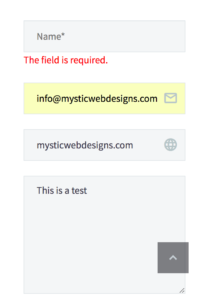Launching a website is a huge undertaking and often a lot of functions are missed while testing. Your QA test the website but it is also important for the different users who played a role in producing the roadmap of the site to test all areas like the project manager, designer, and the stakeholder.
Design Review – Make sure the designer reviews the design, this is often missed by the developer. Designer has an eye to catch the one pixel off, misalignment, and the slight change in the colors.
Fonts – Make sure there is consistency in the fonts sitewide. It looks awful when a CMS page has different fonts on different pages.
Images – Make sure images are optimized for websites. Images have a huge effect on the website speed.
Spelling – I have always found spelling mistakes on a website, especially when the work is outsourced to a different country. The word colour in England is spelled different than color in United States.
Grammar – Check for typos and punctuation on all the pages, images, call to actions, buttons, and navigation menu.
Links – Make sure all the links are redirected to the relevant pages, and there are no dead links.
Cross-browser Testing – Make sure the site is compatible with different browsers like Chrome, Safari, Firefox, Internet Explorer, Edge.
Forms – Fill in forms and check that the forms are submitted correctly. If there are any mandatory fields that are not filled in correctly then an error message should display.

Site Speed – Check the pages site speed. You can check it for free with Google tools.
404 Page – A page not found must be integrated as a default page. Google shows an error if the site does not have a 404 page setup.

301 Redirects – If you are re-platforming an existing site then make sure that your old links are redirected to the correct page. Try to create a list of your old links and test them before the launch.
SSL Certificate – Make sure that SSL certificate is installed on your site. This has become a mandatory feature. Sites without SSL show that they are not secure and users will not trust such sites. You can get a free SSL from Let’s Encrypt.
Notifications – Certain actions populate notifications like when a password is entered incorrectly or the name field is not filled. Test the notifications and make sure that relevant notifications show up.
Responsive – Test site on mobile and iPad. Make sure the site works on all kind of devices.
Emails – If users can create accounts on your site, then test the emails sent by the system. An email confirmation after a user creates an account is sent automatically with the account information.
e-Commerce sites – It is important that payment and shipping are tested from the checkout page. You want to make sure that the information displayed is accurate.
Backend – This is where you manage your content, images, products, and anything that shows on your website. Create listings, or CMS pages and make sure the changes are updated on your website.
Meta Tags – Make sure that your pages or products have meta titles and meta description. Do not copy and paste the same content. Duplicate content raises a red flag with Google.
Hosting – Host your staging site on the hosting server and test the environment. Make sure the site speed is not delayed after hosting. Test all scenarios in the new environment.
Schedule your launch – Last but not the least, don’t rush with your launch. Test, test, and test as much as you can before launching. A rushed launch can hurt your business and leave a bad reputation with your customers.

